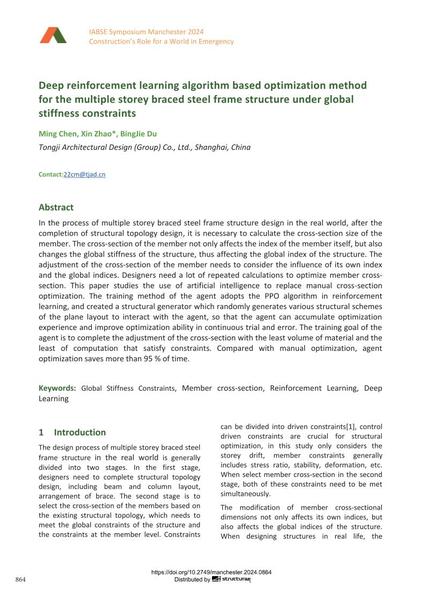Deep reinforcement learning algorithm based optimization method for the multiple storey braced steel frame structure under global stiffness constraints

|
|
|||||||||||
Détails bibliographiques
| Auteur(s): |
Ming Chen
(Tongji Architectural Design (Group) Co., Ltd., Shanghai, China)
Xin Zhao (Tongji Architectural Design (Group) Co., Ltd., Shanghai, China) Bingjie Du (Tongji Architectural Design (Group) Co., Ltd., Shanghai, China) |
||||
|---|---|---|---|---|---|
| Médium: | papier de conférence | ||||
| Langue(s): | anglais | ||||
| Conférence: | IABSE Symposium: Construction’s Role for a World in Emergency, Manchester, United Kingdom, 10-14 April 2024 | ||||
| Publié dans: | IABSE Symposium Manchester 2024 | ||||
|
|||||
| Page(s): | 864-870 | ||||
| Nombre total de pages (du PDF): | 7 | ||||
| DOI: | 10.2749/manchester.2024.0864 | ||||
| Abstrait: |
In the process of multiple storey braced steel frame structure design in the real world, after the completion of structural topology design, it is necessary to calculate the cross-section size of the member. The cross-section of the member not only affects the index of the member itself, but also changes the global stiffness of the structure, thus affecting the global index of the structure. The adjustment of the cross-section of the member needs to consider the influence of its own index and the global indices. Designers need a lot of repeated calculations to optimize member cross- section. This paper studies the use of artificial intelligence to replace manual cross-section optimization. The training method of the agent adopts the PPO algorithm in reinforcement learning, and created a structural generator which randomly generates various structural schemes of the plane layout to interact with the agent, so that the agent can accumulate optimization experience and improve optimization ability in continuous trial and error. The training goal of the agent is to complete the adjustment of the cross-section with the least volume of material and the least of computation that satisfy constraints. Compared with manual optimization, agent optimization saves more than 95 % of time. |
||||
